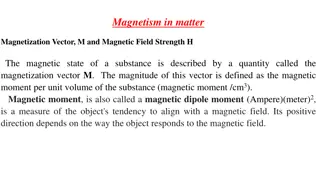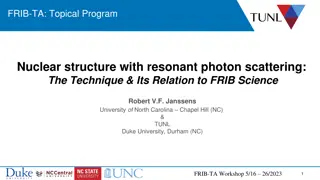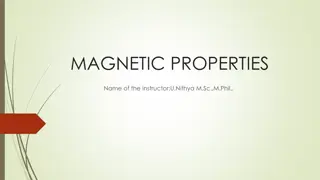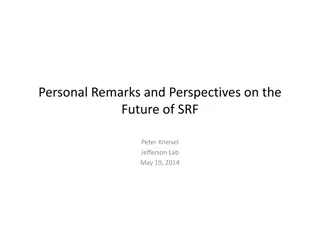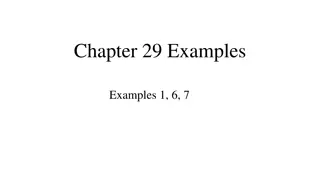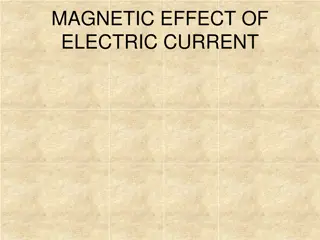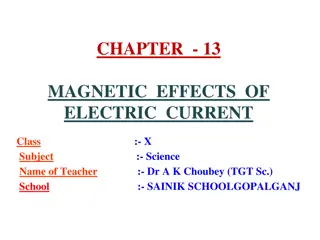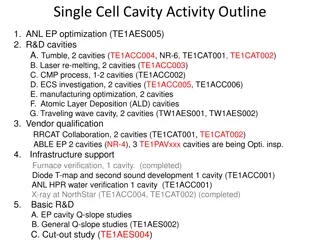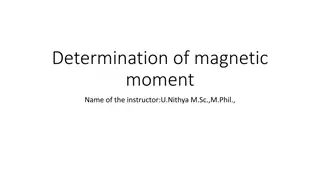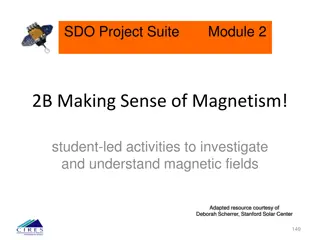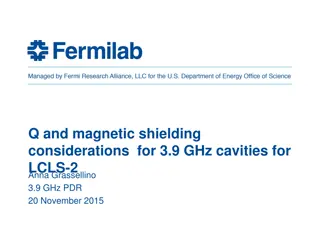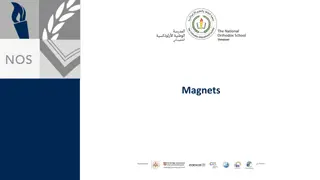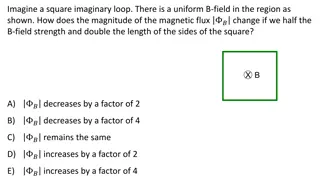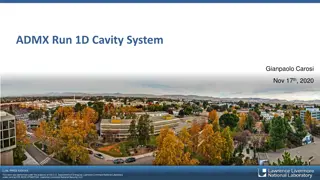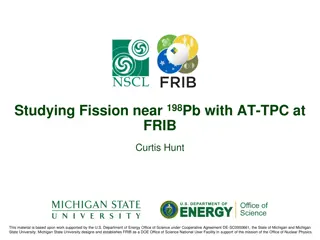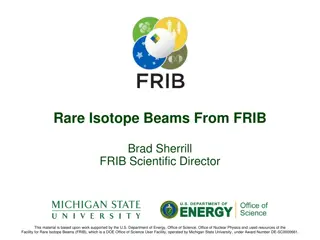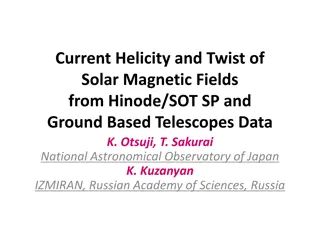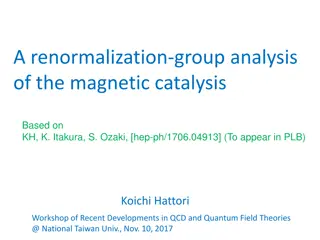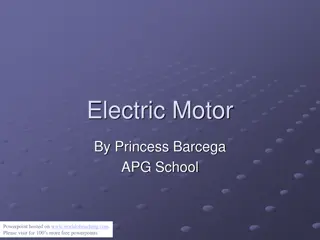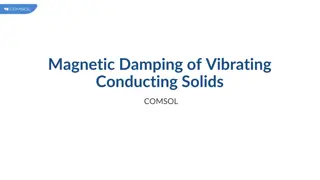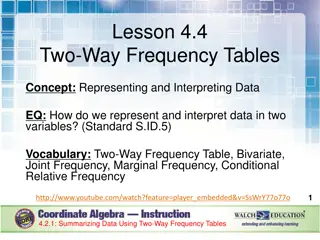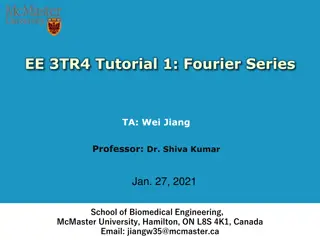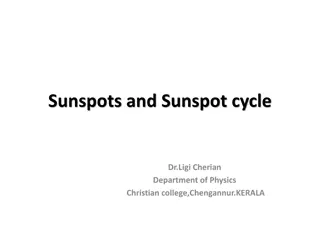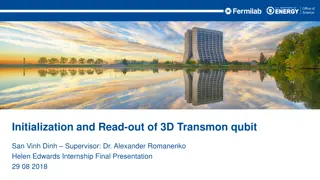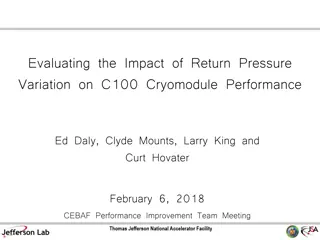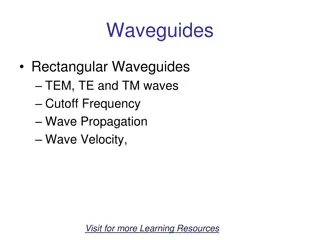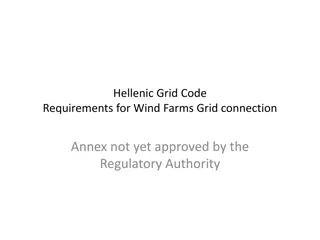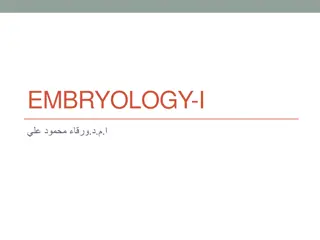Magnetic Field Suppression and Cavity Frequency Control in SRF Development at FRIB
This material discusses the techniques used at the Facility for Rare Isotope Beams (FRIB) to suppress magnetic fields and control cavity frequencies. It covers topics such as remnant field suppression, solenoid package design, validation tests, and magnetic shield material validation for the FRIB cryomodules. The focus is on achieving stringent field suppression requirements for optimal operation. The research is supported by the U.S. Department of Energy and Michigan State University.
Download Presentation

Please find below an Image/Link to download the presentation.
The content on the website is provided AS IS for your information and personal use only. It may not be sold, licensed, or shared on other websites without obtaining consent from the author. Download presentation by click this link. If you encounter any issues during the download, it is possible that the publisher has removed the file from their server.
E N D
Presentation Transcript
Magnetic field suppression, cavity frequency control, MP free coupler K. Saito MSU/FRIB, SRF Development Manager This material is based upon work supported by the U.S. Department of Energy Office of Science under Cooperative Agreement DE-SC0000661, the State of Michigan and Michigan State University. Michigan State University designs and establishes FRIB as a DOE Office of Science National User Facility in support of the mission of the Office of Nuclear Physics.
Magnetic Field Suppression of FRIB Magnetic Field Suppression in the FRIB Cryomodule 8 T solenoid is placed nearby cavities FRIB concerns two things: Suppression of remnant field, especially earth magnetic field Fringe field from the solenoid package (8 T) Remnant Field suppression FRIB spec is remnant field < 15 mG in the magnetic shield Carbon steel vacuum chamber works as a magnetic shield: attenuation ~ 2 (measured) Local magnetic shield around cavity, 20-30K: reliable shield effect and cost reduction Used conventional Mu-metal (PC Permalloy) with > 9000 at 20 K for cost reduction Firing field suppression Fringe field < 300 G on the local magnetic shield surface Well designed solenoid package with bucking coil (cancellation), no Iron Yoke K. Saito, July 6 2016 TTC meeting WG2 , Slide 2
Solenoid Package Design Attenuation measurement at 10 K for 0.085QWR cylindrical magnetic shield: remarkable field increase in the shield at > 300 G Solenoid design goal: Fringe field < 300 G on the magnetic shield surface Critical field 300G (30 mT) Fringe field 270 G on the shield surface K. Saito, July 6 2016 TTC meeting WG2 , Slide 3
Validation Test with remnant field in ReA6-1 (QWRs) Local shield performance at 25 K (cavity 4.3K): 2.5 mG at RF high magnetic field area Fringe field suppression: 162 mG during solenoid operation at 8 T Degaussing effect, yes; 31 mG to 4.2 mG after degaussing Remnant field after warmed up (300 K): 0 mG K. Saito, July 6 2016 TTC meeting WG2 , Slide 4
Magnetic Shield Material Validation in FRIB QWR first Cryomodule The simulation for the QWR magnetic shield concluded that the shield material with the magnetic permeability > 9000 at 20 5K can meet the FRIB requirement < 15mG. Conventional Mu-metal can meet this condition according to KEK measurement at 4K Proposed to use the conventional Mu-metal for FRIB QWR magnetic shield instead of cryogenic shilled material for instance A4K in order to reduce cost. Cryogenic material cost expensive as much as three time that of conventional one ASAC2016 Dec recommended to validate the shield performance in the FRIB-1 CM ASD accepted the recommendation and two different magnetic shield materials: A4K and Mu-metal, both from Amuneal Co.. K. Saito, July 6 2016 TTC meeting WG2 , Slide 5
Magnetic Shield Material Validation against Remnant Field in the Cryomodule The magnetic shielding performance is poor at the cryogenic temperature, the cavity will make flux trapping during cool down. FRIB requirement is Bin < 15mG. The cavity dynamic load (at 5.6 MV/m) at 2K has no significant difference between Mu- metal and A4K shielded cavities, except for Cavity#1, which was found wrong calibration later, actually measured at ~ 9 MV/m Earth magnet filed ~ 0.5G Magnet filed ~ 0.3G Magnetic shield Vacuum vessel by carbon steel Bin< 15mG solenoid (calibration was wrong, really ~ 9 MV/m) Mu-meatal shield A4K shield K. Saito, July 6 2016 TTC meeting WG2 , Slide 6
Magnetic Shield Material Validation Against Fringe Field from Solenoid Package Charge 2 The material validation against the fringe field Cavity is in Meissner state before solenoid excitation. Fringe field ~ 270 G at 8 T solenoid operation should has no impact on the cavity performance Compared cavity dynamic heat load at 2 K between w/o solenoid package full operation Two combined operations: C#1+S#1+C#2 (Mu-metal) and C#7+S#3+C#8 (A4K) Measurement error ~ 2 W in date fitting 15 min. fit for solenoid on During solenoid package witching off Solenoid package on Solenoid package on 3 min. fit for solenoid on Similar cavity dynamic head load at solenoid switched on/off, validated MU- metal against fringe field The reason why different from switch off is under investigating Solenoid on Data it15min/3min Solenoid off Data fit 3min C#1+S#1+C#2 Mu-metal shield 5.9 W/4.5 W 2.8 W C#7+S#3+C#8 A4K shield 7.6 W/5.3 W 2.3 W K. Saito, July 6 2016 TTC meeting WG2 , Slide 7
Magnetic Contamination FRIB controls the residual magnetization less than 15 mG. If the component used in the magnetic shield has magnetization > 15 mG, we will demagnetize. Even stainless for instance SU316, magnetizes rather ( ~ 1G) when machined or welded. The tools for example wrenches, shackles ... made of hard steel are usually magnetized > 2 mG and magnetizes the bolts and fastener ~ 1G. Examples 1) Shackles Using the solenoid arm lifting, original shackles were made of carbon steel and magnetized > 2 G, Changed to stainless but still magnetized 2) Wrenches Using tightening the fasteners and nuts on the cavity flanges. The wrench magnetized 1.3 G and magnetic contaminated the nuts 960 mG. As received 1930 mG 1950 mG Post demagnetizing 200 mG 380 mG A B K. Saito, July 6 2016 TTC meeting WG2 , Slide 8
Magnetization Test of Stainless Fastener Easily magnetized > 10 G but attenuates within 20 mm Magnetized field attenuation by space distance from the surface Magnetization results In the world of the 1 mG remnant field control like LCLS-II 1) Materials of Tooling, Fixtures will be very much carefully chosen. 2) Perfectly none magnetic materials should be used for fasteners and nuts, for instance hard copper (NC25) instead of stainless. Transvers Longitudinal K. Saito, July 6 2016 TTC meeting WG2 , Slide 9
Cavity Frequency Control Frequency control is much harder than elliptical cavities EBW of QWRs or HWRs are much more complicated compared to elliptical cavities. Cavities frequency tuning is not easy by EBW assembly. FRIB developed reference fixtures to increase reproducibility in the stack-up and trim step of HWR fabrication. Niobium Outer and Inner Conductor Measurement niobium outer and inner conductors are left long. Frequency is determined by stacked-up measurement using calibrated reference copper short plates. The outer and inner conductors are trimmed and re- stacked until goal frequency is met. Niobium Short Plate Measurement niobium short plates are machined complete to drawing. Frequency of finished short plates are measured against a calibrated reference copper cavity. K. Saito, July 6 2016 TTC meeting WG2 , Slide 10
Cavity Frequency Control Example HWR Frequency control during cavity fabrication HWR = 0.53 Frequency Tracking 322.500 Tuner Preload, 322.060 Change Temp, 322.070 Tuner Center, 322.000 Vessel Weld (From ACL), 321.614 Virtual Weld, 321.765 322.000 Change Epsilon, 321.618 Ebeam Weld, 321.608 Bulk Chemistry, 321.506 Frequency (MHz) 321.500 Light Etch, 321.530 Heat Treatment, 321.530 Differential Etch, 321.456 321.000 320.500 Final Stack, 320.308 Controlled within ~ 125 kHz 320.000 0 1 2 3 4 5 6 7 8 9 10 11 12 13 Process Step Planned 53-002 53-003 53-004 53-005 53-006 53-007 53-008 53-009 53-010 Max Min K. Saito, July 6 2016 TTC meeting WG2 , Slide 11
FRIB Innovations Cavity frequency fine tuning methods Differential etching for QWR frequency control Remove high E-field area locally Possible to increase cavity frequency within 5% accuracy Virtual welding for HWR cavity frequency control Cavity shrinkage by EBW to increase cavity frequency Possible to increase cavity frequency within a few % accuracy Virtual TIG welding Increase cavity frequency for HWRs with helium vessel f= 1/2 ?? K. Saito, July 6 2016 TTC meeting WG2 , Slide 12
Baseline FPC and Multipacting Free FPC FRIB HWR coupler: 4 kW @ CW, traveling wave 16 kW Multipacting barrier at low power level RF condition needs > 30 hr , very much time consuming process RF power was limited the MP by 2 kW at TDCM test 2012 Need to improve coupler performance against multipacting Proposed MPF coupler by S. Zheng Original design of MPF FPC FRIB MPF FPC design 5 hr up to 2 kW 10 hr 2kW to up to 8 kW (a) K. Saito, July 6 2016 TTC meeting WG2 , Slide 13
Multipacting Free HWR Power Coupler MPF FPC Demonstrated Excellent Performance During High Power Conditioning Multipacting Free Fundamental Power Coupler Increase impedance (75 ) and push the MP level higher No choke structure at RF window Beam blinded RF window structure Base line MPF Baseline FPC conditioning 9 out of 10 Baseline Model are conditioned but has heavy multipacting heating at 9 -10 kW (traveling wave model) and very long conditioning time. #9 can not reach vacuum goal during after 140 hour conditioning Required time [h]*1 CW 5 kW*2 Conditioning setup Heating BL#3 + BL#4 40 #3 80 C, #4 80 C BL#5 + BL#6 51 #5 80 C, #6 80 C BL#7 + BL#8 63 None BL#9 + BL#10 140 #9 120 C, #10 40 C BL#2 + 6 None (Conditioned) MPF#1 MPF FPC conditioning No multipacting heating observed Quick conditioning time Confirmed memoirs effect at least 2 week in the air cleanroom Conditioning setup Required time [h]*1 Heating CW 5 kW*2 MPF#1 + MPF#2 18 None MPF#1 + MPF#2 9 None T. Xu, June 2016 DOE OPA Review B03, Slide 14 MPF#1 + MPF#2 7 None


